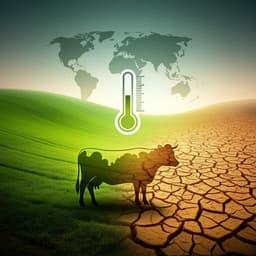
Environmental Studies and Forestry
Impact of population aging on future temperature-related mortality at different global warming levels
K. Chen, E. D. Schrijver, et al.
This study reveals alarming links between population aging and global warming's impact on temperature-related mortality. Researchers found that as global temperatures rise, so do heat-related deaths, significantly influenced by aging demographics. Conducted by a team of experts including Kai Chen and Evan de Schrijver, this research underscores the urgent need to address the dual crises of climate change and population health.
~3 min • Beginner • English
Introduction
Climate change poses profound public health threats for current and future generations. Heat has the most immediate and direct health impact, and recent anthropogenic warming has already contributed substantially to heat-related deaths. Cold exposure is also linked to increased morbidity and mortality, with non-optimal temperatures accounting for millions of deaths annually and the burden historically dominated by cold. Projections typically suggest increases in heat-related mortality and decreases in cold-related mortality with warming, but most analyses have not accounted for demographic shifts. Meanwhile, the global population aged 65 and above is projected to rise markedly by mid-century, and older adults have heightened vulnerability to temperature extremes due to physiological, clinical, and social factors. This study investigates how population aging modifies projections of temperature-related mortality at different global warming levels (1.5 °C, 2 °C, and 3 °C) using standardized methods across 800 locations in 50 countries/areas, quantifying the specific contribution of demographic change to future heat- and cold-related mortality burdens.
Literature Review
Previous global and regional studies reported that non-optimal temperatures cause millions of deaths per year, with cold-attributable mortality greatly exceeding heat-attributable mortality. Projections under warming have generally found increases in heat-related mortality and declines in cold-related mortality due to fewer cold days. However, most work has not incorporated demographic change, particularly population aging, which increases the number of people at risk and vulnerability. Limited local and regional analyses that considered aging found that demographic shifts can offset or reverse projected reductions in cold-related mortality. There is a lack of global-scale evidence with a systematic, standardized analytical approach that explicitly estimates the contribution of aging in future climate-health scenarios. This study addresses that gap by integrating age-specific exposure-response relationships and baseline mortality projections within CMIP6-based climate scenarios.
Methodology
Study design: Multi-country assessment of future temperature-related mortality under different levels of global warming, quantifying the contribution of population aging. Data from 800 locations in 50 countries/areas were obtained through the MCC Collaborative Research Network (over 83 million deaths). Two scenarios were evaluated: climate-only (constant population size, structure, and age-specific mortality at 2015 levels) and climate-population (time-varying population size, demographic structure, and age-specific mortality under SSP5, with SSP3 used in sensitivity analysis).
Climate data and warming levels: Daily mean near-surface air temperature projections (1980–2100) were drawn from 18 CMIP6 GCMs (ACCES-CM2, AWI-CM-1-1-MR, BCC-CSM2-MR, CESM2, CNRM-CM6-1, CNRM-CM6-1-HR, CNRM-ESM-2-1, GFDL-ESM4, IITEM-ESM, INM-CM4-8, INM-CM5-0, IPSL-CM6A-LR, MIROC6, MIROC-ES2L, MPI-ESM1-2-LR, MRI-ESM2-0, NORESM2-MM, UKESM1-0-LL) under SSP5-8.5 and SSP3-7.0. Model outputs were bias-corrected and statistically downscaled at each location using a trend-preserving approach with observed temperatures. Future 20-year windows corresponding to the first crossing of 1.5 °C, 2 °C, and 3 °C above pre-industrial (1850–1900) were identified: under SSP5-8.5 as 2018–2037, 2032–2051, 2055–2074; under SSP3-7.0 as 2021–2040, 2037–2056, 2066–2085. The historical baseline was 1995–2014.
Population and baseline mortality: Country-level projections of population size and mortality rates for age groups 0–64, 65–74, and ≥75 years were obtained from the SSP Database (version 2.0) for SSP5 and SSP3 in 5-year steps (2015–2100). These were interpolated to annual series using natural splines, then transformed to location-age-specific baseline mortality using: (1) an age factor (share of deaths by age group in 2015), (2) a country-to-location factor (share of total deaths at each location vs. country total, based on 1994–2015 data), and (3) a seasonal factor (average daily share of annual deaths by day-of-year to preserve seasonality). For the climate-only scenario, future baseline mortality series were generated by repeating historical daily mortality (1995–2014) through 2100, holding population constant.
Temperature–mortality exposure–response: A two-stage time-series approach was used. First stage: generalized linear model with quasi-Poisson family and a distributed lag non-linear model (DLNM) for each location to estimate exposure–response functions (ERFs), with natural cubic splines for temperature (knots at 10th, 75th, 90th percentiles) and for lags up to 21 days (three internal knots on log scale). Time trends and seasonality were controlled using natural splines for date (8 df per year) and day-of-week indicators. Second stage: extended mixed-effects multivariate meta-regression pooling location-specific ERFs with fixed meta-predictors (average temperature, temperature IQR, country GDP) and two-level random effects (cities nested within country-specific Köppen–Geiger climate zones). Best linear unbiased predictions (BLUPs) were derived per location, and minimum mortality temperature (MMT) was identified within the 2nd–98th percentile temperature range. Age-specific ERFs for 0–64, 65–74, and ≥75 years were obtained using factors from a dose-response multivariate meta-analytical model developed by the consortium.
Health impact assessment: For each location and period (historical and future windows), daily heat- and cold-related excess deaths were calculated by applying age-specific ERFs to projected daily temperatures and baseline mortality, summing days above MMT (heat) and below MMT (cold). Excess mortality fractions (EF, %) were computed by dividing excess deaths by total deaths. Changes in EF were calculated as differences between each future window and historical period for both scenarios. The contribution of population aging was quantified as the difference between the climate-population and climate-only changes in EF. Uncertainty was assessed using 1000 Monte Carlo simulations of ERF coefficients and across the 18-GCM ensembles to derive empirical 95% confidence intervals (2.5th–97.5th percentiles).
Assumptions and sensitivity analyses: No explicit adaptation over time was assumed (constant ERFs). Sensitivity analyses using SSP3-7.0 showed similar temperature-related mortality estimates and aging contributions to those under SSP5-8.5.
Key Findings
- At 1.5 °C, 2 °C, and 3 °C of global warming, projected increases in heat-related excess mortality fractions across 800 locations are approximately 0.5%, 1.0%, and 2.5%, respectively; 20–25% of these increases are attributable to population aging.
- Cold-related mortality, which would decrease under climate change alone, is mostly offset by population aging, resulting in a net increase in cold-related excess mortality fractions by about 0.1% to 0.4% at 1.5–3 °C of warming.
- Under SSP5-8.5, climate-only scenario (vs. 1995–2014): cold EF changes of −0.60%, −1.03%, −1.75% at 1.5 °C, 2 °C, 3 °C; heat EF changes of +0.38%, +0.77%, +1.83%; net non-optimal EF changes of −0.22%, −0.25%, +0.08%.
- Under SSP5-8.5, climate-population scenario: cold EF changes of +0.08%, +0.43%, +0.17%; heat EF changes of +0.46%, +1.04%, +2.50%; net non-optimal EF changes of +0.54%, +1.48%, +2.67% at 1.5 °C, 2 °C, 3 °C, respectively.
- Similar results were obtained under SSP3-7.0. Increases in non-optimal EF attributable to population aging alone averaged 0.8% (95% eCI: 0.6%–0.9%), 1.7% (1.2%–2.1%), and 2.6% (0.9%–3.5%) at 1.5 °C, 2 °C, and 3 °C.
- Country examples (climate-population, non-optimal EF change): Vietnam +13.2% (heat +14.2%, cold −1.0%); Kuwait +10.0% (cold +5.1%, heat +4.9%); French Guiana +24.1% (wide uncertainty, heat dominant); Philippines +11.3%; Martinique +10.6%. Decreases were observed in Colombia −5.4% (both cold and heat declines, not statistically significant), Moldova −3.2%, Estonia −2.5%, and Japan −0.9%.
- Population aging attenuates or reverses climate-driven declines in cold-related mortality in many countries: at 1.5 °C, 18 of 50 countries/areas show increased cold EF when aging is included; at 2 °C and 3 °C, 23 and 21 countries/areas, respectively, show increased cold EF.
- Heat EF increases in nearly all countries under climate change alone; aging adds a smaller but non-negligible increment (approximately +0.1% to +0.7% at 1.5–3 °C), implying that roughly one in five to one in four additional heat-related deaths are due to aging.
- Overall, including population aging yields consistent increases in non-optimal temperature-related mortality at all warming levels, with a larger net burden at 2 °C than 1.5 °C in most countries (47/50).
Discussion
The study shows that demographic change, particularly population aging, is a critical driver of future temperature-related mortality. While climate warming alone tends to increase heat-related mortality and decrease cold-related mortality, the rapidly growing share of older adults offsets much of the cold-related decline and adds to the heat-related increase, producing a net rise in mortality due to non-optimal temperatures at 1.5 °C, 2 °C, and 3 °C of global warming. These findings address a key research gap by explicitly quantifying aging’s contribution in global projections using standardized age-specific exposure–response functions and baseline mortality. The results suggest that without accounting for aging, projections may underestimate future mortality burdens, especially for cold. Compared with previous studies using older climate scenarios (SRES, RCP), this analysis with CMIP6 GCMs and SSPs corroborates a net increase in temperature-related mortality when demographics are included. The work also clarifies differences between 1.5 °C and 2 °C impacts: once aging is considered, most countries have higher mortality burdens at 2 °C than at 1.5 °C. The findings underscore the need for integrated climate mitigation and targeted adaptation strategies focusing on older populations and health systems.
Conclusion
This study provides the first global quantification of population aging’s contribution to future temperature-related mortality across warming levels around and beyond the Paris Agreement targets, using an extensive MCC dataset, CMIP6 multi-model ensembles, and age-specific exposure–response relationships. Accounting for aging reveals consistent increases in overall temperature-related mortality at 1.5 °C, 2 °C, and 3 °C, with aging being a dominant factor for cold-related mortality and a substantial contributor to heat-related mortality. Policy implications include prioritizing ambitious mitigation to limit warming and implementing targeted adaptation for older adults (e.g., heat–cold action plans, health services, infrastructure, and social support). Future research should incorporate potential adaptation dynamics, develop sub-national demographic projections, expand coverage in data-scarce regions (notably South Asia and Africa), and refine age-specific vulnerability assessments to improve precision and generalizability.
Limitations
- No explicit modeling of population adaptation to heat or cold over time; ERFs assumed constant, which may overestimate or underestimate future impacts but allows disentangling aging from climate effects.
- Lack of sub-national projections of population aging for all countries may reduce spatial precision.
- MCC locations are predominantly urban; results may not represent countrywide averages, and some countries have only one or two cities.
- Limited data coverage for parts of South Asia and Africa, regions expected to experience substantial demographic change, likely making estimates conservative for those areas.
- Uncertainty remains in ERFs and climate projections despite using ensemble methods and Monte Carlo simulations.
Related Publications
Explore these studies to deepen your understanding of the subject.







